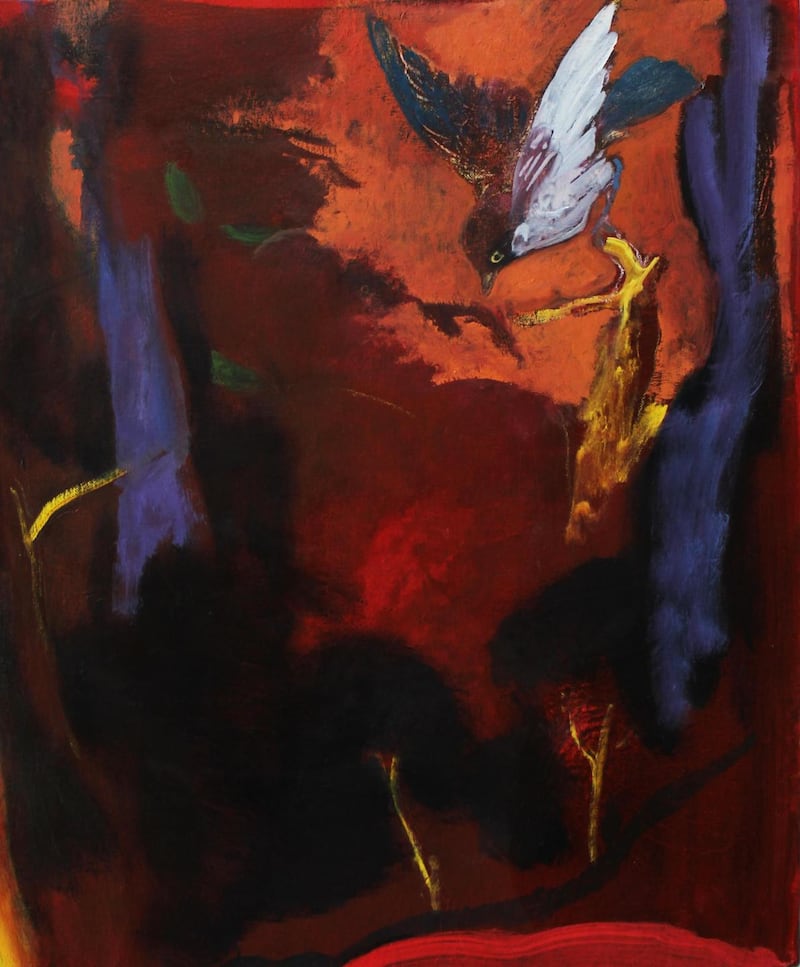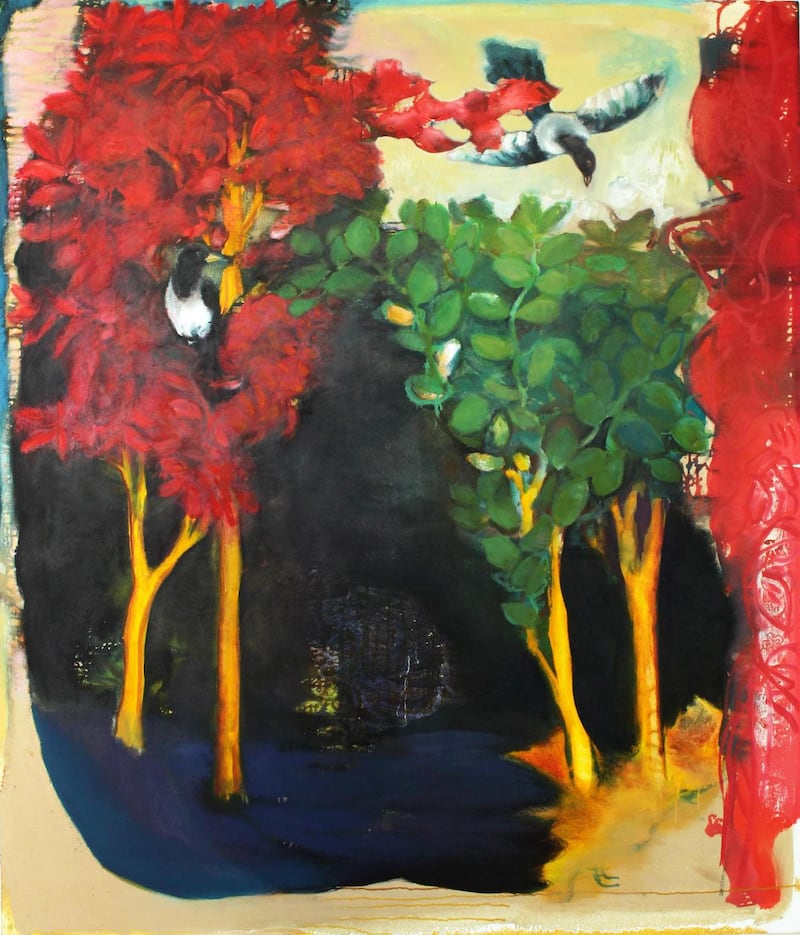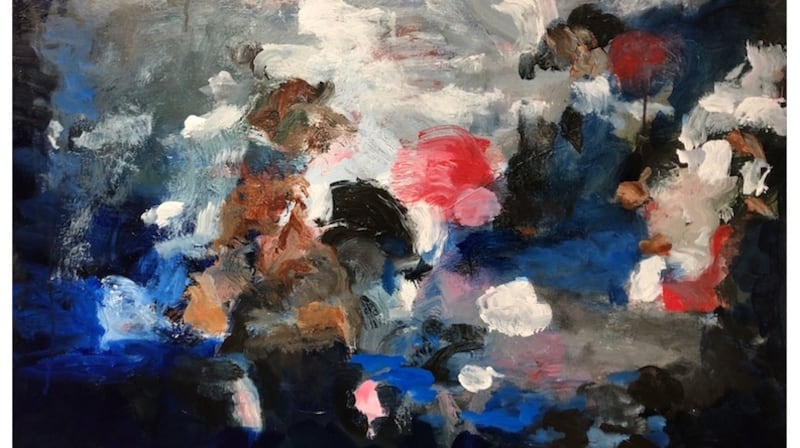Jonathan Hunter: Garland
Hillsboro Fine Art, Dublin
★★★★☆
Jonathan Hunter has followed a singular path in his painting, which might at first glance seem nostalgic for a distant past, but is in fact very much of the present moment, an immediate response to being in the world. Long based in Ireland, he is originally from Hexham in England, first studied art in Dundee, then Birmingham, and finally completed an MFA at the National College of Art and Design (NCAD) in Dublin.

Landscape is central to his work, together with human and animal figures, often with an allegorical hint about them. Back in 2008 he had a residency at the Albers Foundation at Bethany in the US and made a substantial body of work there, inspired by, but not literally, depicting its woodland setting.
When he exhibited that work he quoted the 17th century Chinese painter and theorist Shih-t’ao’s treatise on painting. In painting the landscape the aim, Shih-t’ao said, was “to create vibrant energy with haphazardness. This is so, not to be explained.” It remains a good description of what Hunter does.

It is likely that the relevant landscape in his recent work is the Phoenix Park. Not only the wooded landscape but also the dog that accompanies the artist on regular walks in the park features in the paintings. But, as in Bethany, Hunter quotes selectively from the landscape, and he shows no interest in a naturalistic palette.

Far from it, he mostly uses intense, hot colours, vibrant purples and reds, flashes of golden yellow, luxuriant blue folds. Unlikely colour choices, but he uses them brilliantly.
And he doesn’t create an even, overall surface texture. With a nod to Shih-t’ao, extensive passages of the paintings are rendered as fast, spontaneous washes of tone and almost calligraphic linear marks, deftly rendered, which merge seamlessly with more consolidated areas of opaque colour.
That sense of underlying haphazardness is never lost in the process and, despite an attractively dreamy, idyllic character, the works have a brimming energy that teeters on instability.
A study of the dog, curled up asleep in the midst of the wooded setting, leapfrogs the viewer into the animal’s and, by suggestion, the viewer’s own inner world. It is titled When he dreams, he runs. Elsewhere youthful figures, male and female, have an archetypal, timeless aura, as do the deer glimpsed in occasional sightings.
Always, Hunter generates a feeling of being in a dream landscape, like the sense of being on a personal retreat he mentioned in relation to the Bethany woodland during his residency there. His heightened palette and the tropical vegetative richness it suggests, not to mention the motif of the sleeping subject, bring to mind Gauguin’s Tahiti.
But that is in a way incidental. Chinese ink painting is probably even more conspicuous as a referent, as are Watteau’s fêtes galantes, those pictorial idylls with their gracious revellers, joyous scenes inexplicably underscored with a certain wistful melancholy.
The term wistful melancholy could be applied to Hunter’s paintings as well. Watteau was, incidentally, a brilliant, quicksilver draughtsman, and that lightness of touch comes through in his paintings, another point of resonance with Hunter’s work.
[ Hillsboro Fine ArtOpens in new window ]
Stephen Lawlor: needle, acid and brush
SO Fine Art Editions, Powerscourt Townhouse Centre, Dublin
★★★★☆
SO Fine Art Editions has relocated to the handsome second-floor space in Powerscourt Townhouse Centre once occupied by Solomon Fine Art (now in Balfe St nearby). It seems like a brave move at a time when contemporary art galleries – the prefix commercial sounds a bit presumptuous in the circumstances – are facing serious challenges.

It is brave, especially given that the move was necessitated by commercial pressure, a completely unsustainable rent increase on its previous premises. And it leaves SO centrally located.
As the name suggests, the gallery places an emphasis on editioned print works. Like the Graphic Studio Gallery, it holds an extensive stock of fine art prints of various kinds. It also shows applied arts pieces – ceramics, wood and, at the moment, very fine, beautiful enamelled bowls by Susan Mannion. Woven into all this is an exhibition by Stephen Lawlor – Needle, Acid and Brush. Lawlor established his reputation as a printmaker, and then painting became an increasingly important activity for him.
The transition, or combination, is not automatic or particularly common. Printmaking is technically precise and demanding and, often, slow. The technique can become a dominant factor, almost an end in itself.
Lawlor is a technically proficient printmaker who found another dimension in painting. His prints are not really like his paintings. Where his prints are, for the most part, fixed and definite and crisply articulated, his painting is fluid and melting and protean. In fact, in his painting he relishes the protean possibilities of the medium, something further accentuated by his increasing use of aluminium panels: fast, slippery supports by comparison with canvas or even paper.
He does show some prints – etchings, actually – in the show, but mostly paintings. And the paintings are reworkings or variations on classical works, including paintings by Titian, Rubens, Delacroix and Jacapo Bassano.
Lawlor’s method is to free the paint in the source works, to let it flow and mix and find new configurations, pushing it to the point of abstraction but always retaining a recognisable link. Delacroix is a frequent source, perhaps because this great Romanticist, renowned for his free brush-work and high drama, meets Lawlor half-way.











